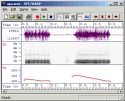Web Resources
On this page you will find a general set of links that you can
use as the starting point of your own investigations on the Internet
for material related to the course. If you have suggestions for other
pages you think would be interesting for students on the course, mail
them to Mark Huckvale.
Week by Week
| Week 1−1 |
Introduction to the course
|
| Week 1−2 |
Sound
|
| Week 1−3 |
Periodic sounds
|
| Week 1−4 |
Harmonic analysis
|
| Week 1−5 |
Frequency sensitivity
|
| Week 1−6 |
Audio recording
|
Week 1-7
|
Filtering
|
Week 1-8
|
Vocal tract filter
|
Weeks 1-9
& 1-10
|
Spectrography
|
Week 2-1
|
Mechanism of the larynx
|
Week 2-2
|
Fundamental frequency analysis
|
Week 2-3
|
Vowels
|
Week 2-4
|
Fricatives
|
Week 2-5
|
Consonant place and manner
|
Week 2-6
|
Plosives and nasals
|
Week 2-7
|
Perception tests
|
Week 2-8
|
Hearing: intensity
|
Week 2-9
|
Hearing: frequency analysis
|
Week 2-10
|
Hearing: complex sounds
|
General Sources of Information
Internet Institute for Speech and Hearing.
A well-organised source of information about web resources in
Phonetics, Speech and Hearing. Has information about books, journals,
tutorials, demos and tools relevant to the Acoustics Course.
Speech Analysis Tools
 |
WASP - Waveforms Annotations Spectrograms and Pitch
WASP is a program for the recording, display and analysis of speech
on personal computers. With WASP you can record and replay speech
signals, save them and reload them from disk, edit annotations, and
display spectrograms and a fundamental frequency track.
|
 |
ESYNTH - Harmonic analysis/synthesis teaching tool
ESynth
is a program designed to explain the harmonic analysis and synthesis of
signals. With ESynth you can create signals by adding together
individual sinusoidal waveforms (sinewaves) and study the resulting
waveform and spectrum. You can also perform an analysis of an input
waveform, to see how a given sound can be represented in terms of a sum
of sinewaves.
|
 |
ESYSTEM - Signals and Systems teaching tool
ESYSTEM is a program for experimenting with signals and systems.
With ESYSTEM you can see the effect of simple systems on a range of
simple signals. You can generate simple signals such as sinewaves,
pulses, pulse trains, sawtooth and noise; you can pass them though
systems such as an amplifier, a resonator, a low-pass, high-pass or
band-pass filter, or a vocal tract model. You can observe the effect on
the input and output waveforms and the input and output spectra. Now
includes extensive tutorial!
|
 |
SFS - Speech Filing System Tools for Speech Research
The Speech Filing System (SFS) is a software suite running on
Windows and Unix systems for the storage and analysis of speech data.
It provides a comprehensive environment for speech signal processing,
synthesis and recognition.
|
Materials in Speech Communication
Collections of Links pages



